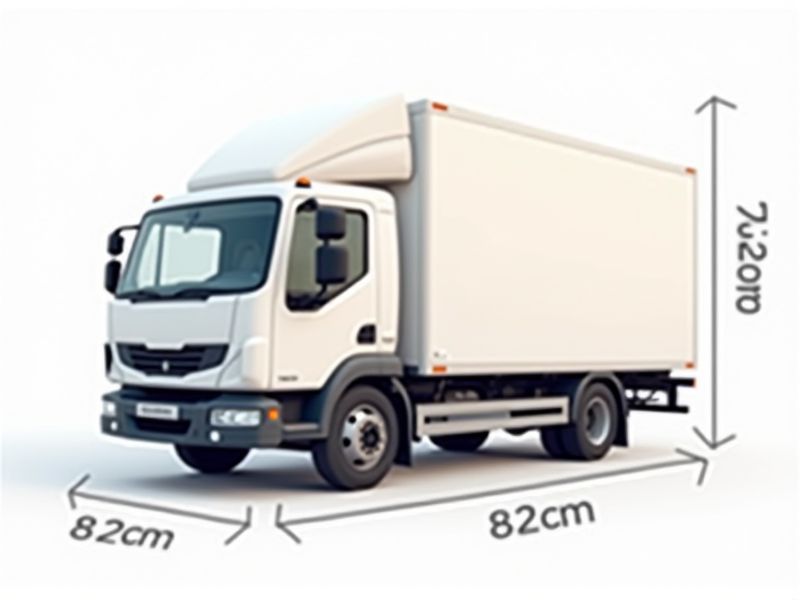
When considering the standard dimensions of a truck, it's helpful to focus on the most common types: light-duty pickups and semi-trailer trucks (18-wheelers). A typical light-duty pickup truck in the U.S. usually measures about 19 feet long, 6.5 feet wide, and 6 feet high. In contrast, the standard semi-trailer truck (tractor-trailer) is typically around 72 feet long (including the cab and trailer), 8.5 feet wide, and 13.5 feet high. Knowing these dimensions can help you plan for parking, loading, or navigating routes where space is limited.
Overall Length
The standard overall length for trucks typically ranges between 20 to 22 feet for light-duty models, while heavy-duty trucks can reach lengths of up to 40 feet or more. This measurement includes the entire vehicle from the front bumper to the rear bumper, ensuring compliance with transportation regulations in various regions. Understanding these dimensions is crucial for proper maneuverability and parking considerations, particularly in urban settings. Manufacturers often provide specifications that cater to specific industries, allowing you to choose a truck that fits your operational needs effectively.
Overall Width
The overall width of a standard truck typically ranges from 80 to 102 inches, directly impacting its maneuverability and loading capacity. An optimal width allows for better stability while navigating tight spaces, making it essential for urban deliveries. When selecting a truck, consider how the overall width will affect your loading dock access and parking options. This dimension not only influences aesthetic appeal but also compliance with road regulations, which may vary by region.
Overall Height
The overall height of a truck is a crucial specification that directly influences its maneuverability and load capacity. Standard heights for trucks typically range from 8 to 13.5 feet, depending on the type and design. Ensuring your truck adheres to these height regulations is essential for compliance with local infrastructure, such as bridges and overpasses. When selecting a truck, consider how its height will affect accessibility to loading docks or tight urban environments.
Wheelbase
The wheelbase of a truck is a critical measurement, representing the distance between the front and rear axles, which significantly influences stability and handling. For example, a longer wheelbase generally enhances ride comfort and reduces sway, making it ideal for towing heavy loads. Typically, commercial trucks range from 140 to over 200 inches in wheelbase measurements, allowing for various configurations tailored to specific needs. Understanding the impact of wheelbase can help you choose the right truck for your transportation tasks.
Ground Clearance
Ground clearance in trucks typically ranges from 7 to 12 inches, significantly impacting off-road capability and load capacity. A higher ground clearance allows for better maneuverability over obstacles, making it ideal for off-road adventures or rugged terrains. For instance, heavy-duty trucks often feature clearance levels of 10 inches or more, enhancing their performance in challenging environments. If you're choosing a truck, consider how ground clearance aligns with your driving needs, especially if you plan to traverse uneven surfaces frequently.
Cargo Bed Length
The standard cargo bed length for full-size trucks typically ranges from 5.5 to 8 feet, designed to accommodate various hauling needs. A 6.5-foot bed is the most common choice among consumers, striking a balance between payload capacity and maneuverability. For heavy-duty applications, an 8-foot bed provides maximum cargo volume, ideal for transporting larger items or equipment. When selecting your truck, consider how the cargo bed length aligns with your specific needs, as it significantly impacts both usability and versatility.
Cargo Bed Width
The cargo bed width of a standard truck typically ranges from 60 to 80 inches, designed to accommodate a variety of payloads. A wider cargo bed enhances your hauling capacity, allowing for larger items such as furniture or equipment to fit securely. For instance, the Ford F-150 offers a bed width of 66.4 inches, maximizing versatility while adhering to industry standards. Understanding the dimensions of your truck's cargo bed can significantly improve your loading efficiency and overall utility.
Cargo Bed Height
The cargo bed height of a standard truck typically ranges from 18 to 36 inches, significantly impacting loading and unloading efficiency. Trucks designed for commercial use often have lower cargo beds, facilitating easier access for forklifts and heavy machinery, while those aimed at off-road performance might feature higher beds for improved ground clearance. Many trucks offer adjustable bed heights or specialized accessories, catering to diverse operational needs and user preferences. Evaluating cargo bed height is crucial for optimizing your productivity, especially when transporting varied loads.
Gross Vehicle Weight Rating
The Gross Vehicle Weight Rating (GVWR) is a critical factor in determining a truck's load capacity, indicating the maximum safe weight of the vehicle, including its own weight and the cargo it carries. Most standard trucks have GVWRs ranging from 10,000 to 26,000 pounds, categorizing them into classes that influence their usage and regulation. Understanding your truck's GVWR is essential for compliance with legal weight limits, which vary by state and can affect tolls, insurance, and safety requirements. Choosing a truck that meets your specific GVWR needs ensures optimal performance and reduces the risk of overloading, enhancing both safety and efficiency on the road.
Turning Radius
The turning radius of a truck is a critical factor that affects maneuverability, particularly in urban environments where space is limited. Typically, a standard truck has a turning radius ranging between 20 to 30 feet, depending on its size and design. A smaller turning radius allows for easier navigation around tight corners and during parking, enhancing operational efficiency. When selecting a truck, consider how well its turning radius aligns with your driving needs and the environments in which you will be operating.
